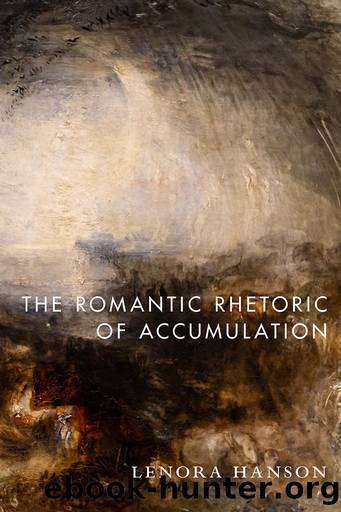The Romantic Rhetoric of Accumulation by Lenora Hanson;

Author:Lenora Hanson;
Language: eng
Format: epub
Publisher: Stanford University Press
Published: 2022-06-15T00:00:00+00:00
Priestleyâs New Chart of History was first published in 1769 and went through as many as twenty editions.14 As Priestley tells us, it is meant to prevent âerror[s] being impressed upon the mind more forcibly by means of sensible images in the brainâ caused by maps âcrowded with figures and explanationsâ and âdifferent scales of time.â Here Priestley makes clear that our understanding of history hinges upon the proportionality of an impression, which, when once made, takes an immense amount of time and labor to undo if, as he says, it imposes too much upon the imagination. What one is after in the production of images and external stimuli is not representational accuracy but rather a feeling in which human history corresponds with the regulatory laws of nature, which Priestley understands to be happily and habitually leading toward âthe extremely favourable . . . progress of knowledge, virtue, and happiness.â Earlier charts of history had been unable to produce sufficient affective balance on account of the mass of data they presented, leading to an imbalance between external stimulation and sense-based understanding and thus an unnecessarily disfigured face of history.15 In Priestleyâs chart, by contrast, âtime here flows uniformly from the beginning to the end of the tablet. It is also represented as flowing laterally, like a river, and not as falling in a perpendicular stream.â According to Daniel Rosenberg, Priestleyâs chronography is part of the first Western attempts to organize time and events using the figure of the line.16 Approaching the representation of time and the inclusion of text on the chart with an understanding that âwe have no distinct idea of length of time, till we have conceived it in the form of some sensible thing that has length, as of a line,â Priestley emphasizes the linearity of time and uniformity of space over the mass of information that would accrue from histories organized through multiple different chronologies or that dictate historical significance through subjectively determined events.17 By means of the linearity of time and the uniformity of space Priestley generates the conditions for sensing history as an economic affair of âconveniences that could not have been had without the inconveniences [and] the pleasures and advantages of society that could not have been had without the disadvantages.â18
Download
This site does not store any files on its server. We only index and link to content provided by other sites. Please contact the content providers to delete copyright contents if any and email us, we'll remove relevant links or contents immediately.
4 3 2 1: A Novel by Paul Auster(11788)
The handmaid's tale by Margaret Atwood(7448)
Giovanni's Room by James Baldwin(6808)
Asking the Right Questions: A Guide to Critical Thinking by M. Neil Browne & Stuart M. Keeley(5356)
Big Magic: Creative Living Beyond Fear by Elizabeth Gilbert(5351)
Ego Is the Enemy by Ryan Holiday(4957)
On Writing A Memoir of the Craft by Stephen King(4662)
The Body: A Guide for Occupants by Bill Bryson(4583)
Ken Follett - World without end by Ken Follett(4443)
Bluets by Maggie Nelson(4261)
Adulting by Kelly Williams Brown(4232)
Eat That Frog! by Brian Tracy(4149)
Guilty Pleasures by Laurell K Hamilton(4116)
White Noise - A Novel by Don DeLillo(3829)
The Poetry of Pablo Neruda by Pablo Neruda(3815)
Fingerprints of the Gods by Graham Hancock(3738)
Alive: The Story of the Andes Survivors by Piers Paul Read(3730)
The Book of Joy by Dalai Lama(3697)
The Bookshop by Penelope Fitzgerald(3619)
